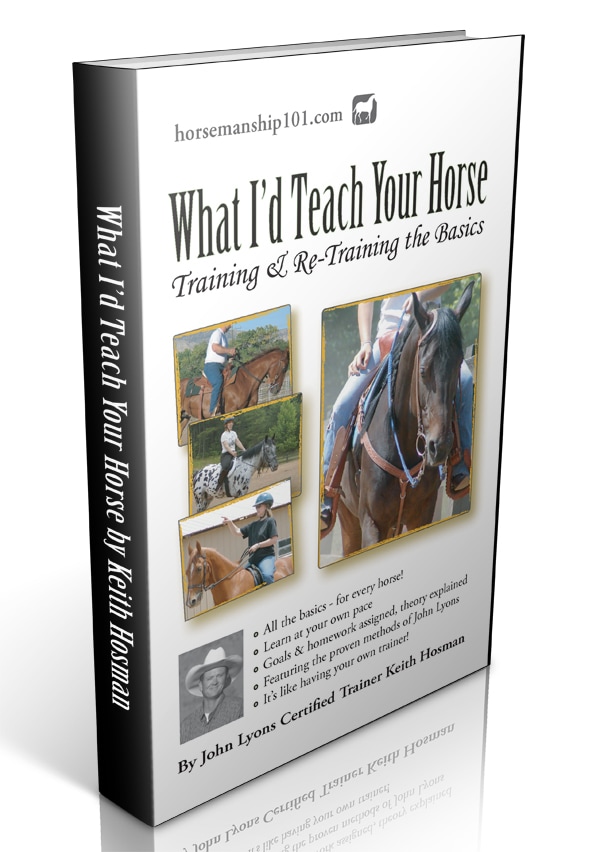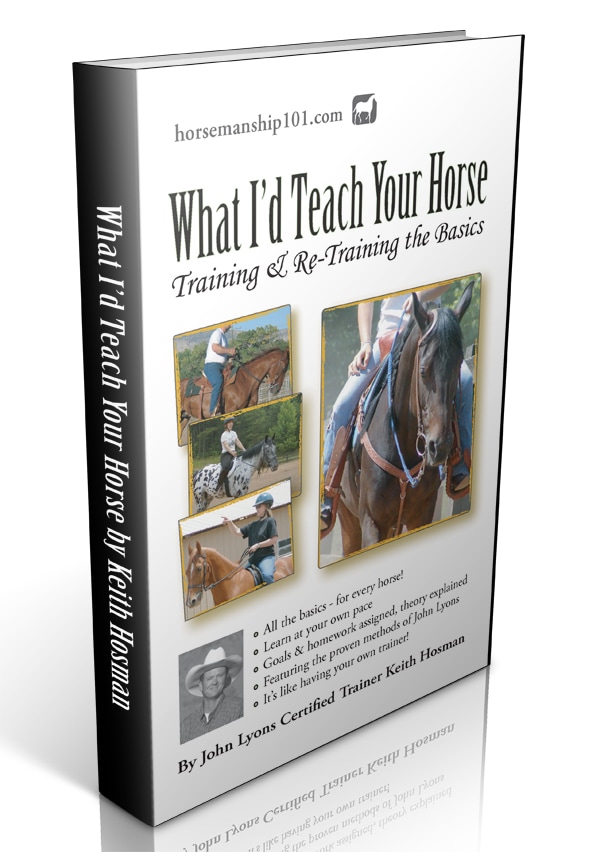What I'd Teach Your Horse: Training and Re-Training the Basics
|
"What I'd Teach Your Horse: Training and Re-Training the Basics"
A book by Keith Hosman, John & Josh Lyons Certified Trainer For sale here by the book's actual author! THIS PAGE: PAPERBACK VERSION Other Formats
This page offers the paperback version only. However, this book is also available:
Click any of the above links to get more info or purchase. Table of Contents
Preface Section I Basically training your horse Legs Mean Move (Step 1 if This Is “Day 2” for Your Young Horse) Your young and very green horse has learned to pack a saddle and you’ve sat on it once or twice—but you’d like to do something more than sit there and wave at your friends as they ride off. You want a horse that... moves. Here’s what to do. Hip Control, Part I Control of your horse’s hips is the key to all the “stuff your horse can do.” Here we start unlocking your horse’s potential with a few basic and easy exercises. Hip Control, Part II Our next objective is to better the horse’s ability to move its hips on request, giving us not just a step or two, but a pivot over his shoulder of a full 180 degrees. Classic Serpentine The Swiss Army knife of training exercises, use this routine to warm up, cool down, lower your horse’s head, connect the rein to the feet, or to soften laterally. Train Your Horse to Travel Straight Training your horse to walk, trot or lope in a straight line is easy. Here’s how to do it. Clockwork: Teach Anything to Your Horse Here’s a great primer for all future training: In the same way that you can use a hammer and saw to build a penthouse, doghouse or outhouse, you can use the “Clockwork Exercise” described here to teach your horse almost anything. Beyond teaching simple cues to “turn left” or “turn right,” you can pick the appropriate numbers and teach a spin, a back up, a side pass... the options are endless. Click here to hear "Clockwork (How to Teach Anything to Your Horse)," an entire chapter from the book "What I'd Teach Your Horse." Shoulder Control How do you know when you know you’ve got no “shoulder control”? Four seconds before your knee hits a tree. Here we get the back half of your horse lined up squarely behind the front half. We’ll fine tune your steering and get the two of you in shape for the more complex work you’ll face when your horse graduates from basic training to graduate school, prepping it for a life as a reiner, eventer—or real cool, pushbutton trail horse. The Reverse Arc Circle We’ll quickly teach the “reverse arc circle” as an example of how to get more advanced shoulder movement using “clock work.” “Reverse Arc Circle” is a fancy way of saying “your horse looks off to one side, but pivots on his back foot going the other way,” (he looks left, spins right). It’s a first step to teaching the reining spin or neck reining. How to Fix Leaning Shoulders If your horse leans over or “drops a shoulder” in a turn, here’s how to fix it. Serpentine: Indirect to Direct Here’s an additional exercise that’ll teach your horse to stay “upright” through his travels and put an end to “corner cutting.” Speed Control Basic Speed Control Presently, your horse knows just two speeds: “Slow” going away from the barn and “fast” going toward it. Here we teach it to slow down and speed up when lightly cued—but also to travel consistently at a wide range of speeds. Slow Down, Part I: Move the Hip If you have problems with your horse getting “higher and higher”—or need ways to slow a fast one down—then the following two sections are for you. Slow Down, Part II: Wherein We Train the Brain When you want to teach your horse to slow down, a simple key is to find a moment when traveling on a loose rein and build on it. Balky Horses: Comatose One Minute, Hot to Trot the Next Here’s what to do when your horse moves slower and slower on the way out of the barn—but faster and faster when headed toward it. Plus: The horse that won’t move. Crossing Creeks and Scary Stuff Forcing your horse across obstacles without proper training is inviting trouble. Here’s how to properly prepare your horse to walk across scary objects like tarps and water and to avoid fights. It’s also great pre-training for teaching your horse to load into a trailer. Teach Your Horse to Lower Its Head While Standing “Horse, quit playing games with that appaloosa and behave yourself. Drop your head, leave it there, quit antagonizing me.” Better Back Ups If you’ve practiced the “Clockwork Exercise,” specifically and successfully teaching your horse to step on “6 o’clock” repeatedly, then your horse can and will back up for you today. What we’ll do here then is work to make the movement smoother and quicker. Simple Steps to Power Steering We’ll use what you learned in the Clockwork Exercise to firmly ingrain in your brain the importance of being specific with your requests—and we’ll see how that precision can be used to turn on a dime and ride circles that don’t look like eggs. Diagonal Movement (“Leg Yields Without the Legs”) What you’ll achieve here: Smooth and easy diagonal lines of travel plus a “polite” horse that moves fluidly from a walk to a trot to a canter on the lightest of cues. What you’ll fix: Horses that want to leap into and speed through their transitions, horses that ignore our cues, horses that just trod along “going through the motions.” Softening Get your horse giving to the bit, dropping its head and rounding its body, rather than bracing when you pick up the reins. Being “rounded” is the crux of collection. Collection gives us a horse that can readily follow our requests with lightness and precision with zero hesitation. Getting Leads Teaching any horse to pick up the correct lead is ninety percent “softening” through its transitions. The rest is “positioning.” A Fix for Cross-Firing (aka “Cross-Cantering”) Q: “How do I fix cross-firing in the lope? How do I even know when it’s happening? Hips, Get Behind the Shoulders (And Stay Put) A little exercise with big results. Teach your horse to automatically align its hips and shoulders in an arc mirroring your line of travel to improve collection and see the following: 1) Rounder circles; 2) Straighter straights; 3) Vastly improved stops. (Oh! And it cures rubber necking!) Hips-in (aka “Haunches-in” or “Travers”) Hips-in is strength training for your horse, a trip to the gym. It asks your horse to “more fully engage” the back inside leg and thus develop a greater ability to “round up” and carry you in a more energized and balanced frame. In turn, you get a more obedient horse that does anything that requires a sudden burst of power, better. (Like sharp turns, standing-start lope departures, pivots, and rollbacks.) Neck Reining How-To Teaching your horse to neck rein is simple—and here’s how. Section II Teaching you, the theory behind the practice The First Thing I Do Here’s the first thing you should do with your horse today—and with any horse that’s “new to you.” Each Time You Mount Up, Do This Here’s one small thing you can do to keep your horse’s attitude in check—and prevent mount-up problems from taking root. How to Pick Up Your Reins Like a Pro It is critical that you become practiced with your hands, your primary source of communication. This is—in detail—how to pick up, handle, and release your reins. Training Magic: Release on the Thought Two days from now your friends at the barn will be pointing at you excitedly, stepping from your path reverently and cooing “oooh” as they watch you ride. What You’re Feeling For Just as another person might reach out a hand to shake yours as you approach, a trained horse will proactively read your body language and act, never waiting for a tug on the reins. Reins Tell Direction, Legs Tell Speed Is your horse getting duller to your cues? Do you make a request only to have him shoot you a condescending glance and go back to what he was doing? It might be that you’re burning out your cues when you use them as both a “heads-up” and motivator. Talking Horse Wouldn’t it be cool if your horse spoke English and you could simply tell him what you were looking for when you’re riding? Well, ta-da! Here’s a trick to get your point across clearly, a technique that’s simple and easy to remember. See Yourself Leading When Riding I’m going to give you a training technique you can use in the saddle, one simple change you can make today that’ll make big—very cool—changes immediately. Your horse will understand your requests far more quickly and all it takes is for you to “see things differently.” Perfect the First Time If you’re guilty of being a bit heavy-handed (as evidenced by a stiff-as-a-statue horse) here’s a Top Five training concept that will soften your horse very quickly. Six Easy Ways to Improve Your Training Here find six horse training tips, each designed to simplify your training and make big changes fast. Rider Checklists Here are 3 “Rider Checklists.” Together, they’ll keep you safer—and accelerate your training to boot. Diagnosing Problems Do you want your horse to stop doing something? Or to start doing something? Either way, the solution lies in asking yourself “What cue or cues plural is my horse ignoring?” Books by This Author Check out these titles from Keith Hosman Meet the Author Keith Hosman, John Lyons Certified Trainer Read a Sample
Click here to read a sample! The sample will open in a pdf document. Hit your "back" button to return to this page. Hear a Sample (on SoundCloud)
Click here to hear "Clockwork (How to Teach Anything to Your Horse)," an entire chapter from the book "What I'd Teach Your Horse." Read by Mike McKenzie If you broke your horse to saddle and rode it for the first time today, this book is where you'd start tomorrow. Likewise, if you have an older horse that needs re-training, you'd start here. This book is a roadmap to building the foundation every horse needs, regardless of age, breed or background, regardless the type of riding for which it will eventually be used.
If you broke your horse to saddle and rode it for the first time today, this book is where you'd start tomorrow. Likewise, if you have an older horse that needs re-training, you'd start here. This book is a roadmap to building the foundation every horse needs, regardless of age, breed or background, regardless the type of riding for which it will eventually be used. Language: English, unillustrated (no photos), 241 pages, SKU: 288
Related books & DVDs:Troubleshooting What Is Wrong with My Horse? by Keith Hosman (book) New to Horses From Ground to Saddle Ground Training Trailer Loading and More by John Lyons (DVD - Note: Also contains a great deal of ground training) Round Penning Round Penning: First Steps to Starting a Horse by Keith Hosman (book) Starting/Breaking How to Start a Horse by Keith Hosman (book) Basic Training Best Start for an Unbroke Horse by John Lyons (DVD) Trail Riding Series by John Lyons (DVD - Note: Don't let the title fool you, this is a great "basic/all-around" training set of DVDs) Young Horse / Babies / Foals Foal Handling by Josh Lyons (DVD includes lessons for trailer-training and ground-training foals) Your Foal: Essential Training by Keith Hosman (book) |




